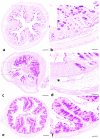Intravenous Immunoglobulin Therapy Eliminates Candida albicans and Maintains Intestinal Homeostasis in a Murine Model of Dextran Sulfate Sodium-Induced Colitis
- PMID: 30909599
- PMCID: PMC6471409
- DOI: 10.3390/ijms20061473
Intravenous Immunoglobulin Therapy Eliminates Candida albicans and Maintains Intestinal Homeostasis in a Murine Model of Dextran Sulfate Sodium-Induced Colitis
Abstract
Intravenous immunoglobulin (IVIg) therapy has diverse anti-inflammatory and immunomodulatory effects and has been employed successfully in autoimmune and inflammatory diseases. The role of IVIg therapy in the modulation of intestinal inflammation and fungal elimination has not been yet investigated. We studied IVIg therapy in a murine model of dextran sulfate sodium (DSS)-induced colitis. Mice received a single oral inoculum of Candida albicans and were exposed to DSS treatment for 2 weeks to induce colitis. All mice received daily IVIg therapy starting on day 1 for 7 days. IVIg therapy not only prevented a loss of body weight caused by the development of colitis but also reduced the severity of intestinal inflammation, as determined by clinical and histological scores. IVIg treatment significantly reduced the Escherichia coli, Enterococcus faecalis, and C. albicans populations in mice. The beneficial effects of IVIg were associated with the suppression of inflammatory cytokine interleukin (IL)-6 and enhancement of IL-10 in the gut. IVIg therapy also led to an increased expression of peroxisome proliferator-activated receptor gamma (PPARγ), while toll-like receptor 4 (TLR-4) expression was reduced. IVIg treatment reduces intestinal inflammation in mice and eliminates C. albicans overgrowth from the gut in association with down-regulation of pro-inflammatory mediators combined with up-regulation of anti-inflammatory cytokines.
Keywords: Candida albicans; Enterococcus faecalis; Escherichia coli; colitis; cytokines; dextran sulfate sodium; inflammation; intravenous immunoglobulin G; mice.
Conflict of interest statement
The authors declare no conflict of interest.
Figures





Similar articles
-
Intestinal colonization by Candida albicans alters inflammatory responses in Bruton's tyrosine kinase-deficient mice.PLoS One. 2014 Nov 7;9(11):e112472. doi: 10.1371/journal.pone.0112472. eCollection 2014. PLoS One. 2014. PMID: 25379804 Free PMC article.
-
Intravenous immunoglobulin (IVIg) or IVIg-treated macrophages reduce DSS-induced colitis by inducing macrophage IL-10 production.Eur J Immunol. 2019 Aug;49(8):1251-1268. doi: 10.1002/eji.201848014. Epub 2019 May 17. Eur J Immunol. 2019. PMID: 31054259
-
Low concentrations of human neutrophil peptide ameliorate experimental murine colitis.Int J Mol Med. 2016 Dec;38(6):1777-1785. doi: 10.3892/ijmm.2016.2795. Epub 2016 Nov 3. Int J Mol Med. 2016. PMID: 27840892 Free PMC article.
-
How Gut Bacterial Dysbiosis Can Promote Candida albicans Overgrowth during Colonic Inflammation.Microorganisms. 2022 May 12;10(5):1014. doi: 10.3390/microorganisms10051014. Microorganisms. 2022. PMID: 35630457 Free PMC article. Review.
-
Intravenous immunoglobulin treatment for fibrosis, atherosclerosis, and malignant conditions.Methods Mol Med. 2005;109:403-8. doi: 10.1385/1-59259-862-5:403. Methods Mol Med. 2005. PMID: 15585934 Review.
Cited by
-
Novel Intravenous Immunoglobulin Therapy for the Prevention and Treatment of Candida auris and Candida albicans Disseminated Candidiasis.mSphere. 2023 Feb 21;8(1):e0058422. doi: 10.1128/msphere.00584-22. Epub 2023 Jan 23. mSphere. 2023. PMID: 36688668 Free PMC article.
-
Deep learning for discovering pathological continuum of crypts and evaluating therapeutic effects: An implication for in vivo preclinical study.PLoS One. 2021 Jun 14;16(6):e0252429. doi: 10.1371/journal.pone.0252429. eCollection 2021. PLoS One. 2021. PMID: 34125849 Free PMC article.
-
Potential Therapeutic Role of Purinergic Receptors in Cardiovascular Disease Mediated by SARS-CoV-2.J Immunol Res. 2020 Dec 1;2020:8632048. doi: 10.1155/2020/8632048. eCollection 2020. J Immunol Res. 2020. PMID: 33299899 Free PMC article. Review.
-
Oleic Acid and Palmitic Acid from Bacteroides thetaiotaomicron and Lactobacillus johnsonii Exhibit Anti-Inflammatory and Antifungal Properties.Microorganisms. 2022 Sep 8;10(9):1803. doi: 10.3390/microorganisms10091803. Microorganisms. 2022. PMID: 36144406 Free PMC article.
-
Could Intravenous Immunoglobulin Collected from Recovered Coronavirus Patients Protect against COVID-19 and Strengthen the Immune System of New Patients?Int J Mol Sci. 2020 Mar 25;21(7):2272. doi: 10.3390/ijms21072272. Int J Mol Sci. 2020. PMID: 32218340 Free PMC article.
References
-
- Sendid B., Dotan N., Nseir S., Savaux C., Vandewalle P., Standaert A., Zerimech F., Guery B.P., Dukler A., Colombel J.F., et al. Antibodies against glucan, chitin, and saccharomyces cerevisiae mannan as new biomarkers of candida albicans infection that complement tests based on c. Albicans mannan. Clin. Vaccine Immunol. 2008;15:1868–1877. doi: 10.1128/CVI.00200-08. - DOI - PMC - PubMed
MeSH terms
Substances
Grants and funding
LinkOut - more resources
Full Text Sources

